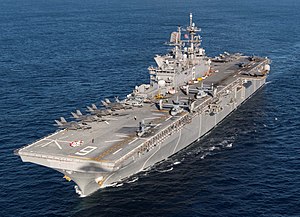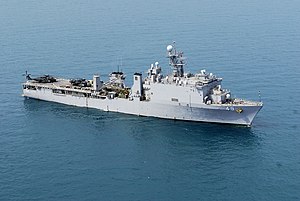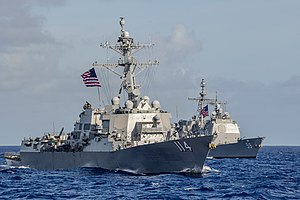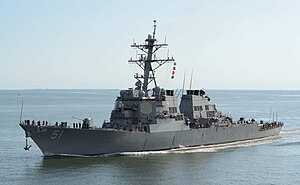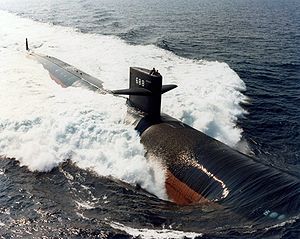Riamese Navy
This article is incomplete because it is pending further input from participants, or it is a work-in-progress by one author. Please comment on this article's talk page to share your input, comments and questions. Note: To contribute to this article, you may need to seek help from the author(s) of this page. |
| Royal Riamese Navy | |
|---|---|
| Founded | 9 June 1719 |
| Website | www.armedforces.gov.ri |
| Personnel | |
| Military age | 18 |
| Industry | |
| Foreign suppliers | |
| Annual exports | |
The Riamese Navy is the naval component of the Armed Forces of Riamo. Her duties include protecting Riamese and regional diplomatic, economical, and social interests, as well as providing an offensive and defensive force capable of defending the nation and its peoples. The navy is also officially part of the Trident System Development Program, a cross-ship multi-national guided missile system installed in over 6 navies and 60 ships.
Role
Functions of the defense force include:
- Defend national interests of Riamo
- Assisting in labors of national security as well as during environmental disasters
- Affirming Riamese position as a leading naval power
- Project a sense of security to the nations with economical, cultural, historical and political ties to Riamo
- Humanitarian Aid and Peacekeeping
Riamo has no separation between navy, coast guard, sea police or anything alike, being the navy the force that encompasses all roles coast guard would also cover in traditional countries.
History
Pre-colonial times
Before the dawn of the Empire the Riamese fleet was mostly composed of smaller trading vessels, with Speer, Butter and Linghtings being common sights. The vast majority of the wartime fleet was not owned by the monarch but rather medieval lords, whose ships would be called to assist the king in case of war but were allowed to operate with normality otherwise.
By the late 14th century, the invention of the Galtiner as an exploration ship allowed Riamese adventurers to start discovering lands far from Metropolitan Riamo, while others like the Portington spread around Guri and the central coast as an efficient armed attack sailing ship.
Empire
By the 16th century, explorers had managed to expand Riamese influence over the waves, with colonies eventually sparkling across and around the Talsar Ocean with massive incentives from the crown. Ships like the Double Galtiner and the Portington were popularized throughout the empire by this time, and would become the backbone of the navy for years to come.
Larger ships like the Tripple would allow for farther exploration by the 17th century, allowing for the colonization of Freice and Gassassinia, among others. It would be variations of the Tripple that helped put Riamese ships at par with the rest of the eastern kingdoms.
Bellic Era
Tall masted wooden vessels would soon be phased out for newer ships by the late 19th century, with cruisers being caught first by the wave of armoured shipbuilding. All first Riamese attempts at armoured shipbuilding proved futile, most including some combination of masts and engines with wood and metal while usually including less than half the safe boats needed for embarking their full crews. By the 1880s sails had proved counterproductive when combined with boilers, being phased out in the Riamese and Neuew navies by 1885.
Armoured & Protected Cruisers
Armoured cruisers would appear in the mid 1880s, featuring am armoured belt on the waterline protective against most direct hits to the broadside, but would soon be proven ineffective against the ever-advancing high penetration projectiles that were appearing by the dawn of the 20th century.
They would be closely followed by the protected cruisers, featuring an internal armoured deck that covered the vital parts and citadel at an angle, increasing effectiveness in relation to thickness, some still proving useful by the late 1920s.
Dreadnoughts
By the dawn of the 20th century it had become obvious that armoured ships were the future. Steam and turrets had replaced wind and cannons, and ships were now truly expensive and heavy. By then ships had multiple calibres that made it hard to guess which splash came from which gun, making the aiming process difficult, reason why Riamese naval engineer Dreadnought envisioned a single calibered armoured ship with 5 turrets. His idea would be quickly adopted by the naval powers of Riamo and Neuewland. Having put afloat the first Dreadnought battleships by 1903, the former would make quick development of engines and turrets, while the latter would pioneer superfiring turrets by 1905. It would take years for most other naval powers to commit to the concept.
Although not the first one laid down, RRS Elizabeth was the first Charles Class Battleship to be commissioned. She pioneered the tripod mast design, inspired by Neuewland's latest dreadnought classes, which would revolutionize Riamese naval construction after 1906.
By 1908 came the iconic Majestuous Class, which stepped up to have 2 tripod main masts as opposed to only one in the Dreadnought Class, with 5 main turrets which would settle the grounds for the second generation of Riamese Dreadnought Battleships. The Majestuous would also show the advantages of not having uniform armour thickness across the ship, helping with manoeuvrability and speed.
Second Generation Dreadnoughts
1911 saw the dawn of the Furious Class Battleships, which stepped down to 4 main turrets and kept Dreadnought's 2 tripod mast configuration. RRN Furious was the first ship in the navy to have an armour belt that did not cover the entire ship's length. This generation was short but proved the effectiveness of uneven armour and superstructures on ships, while proving wrong previous assumptions around efectiveness of casemate guns.
Third & Fourth Generation Dreadnought Battleships
Third generation ships came lead by Blackwood Class in 1916, reintroducing the single tripod mast plus secondary pole mast configuration. Casemates would be utterly abandoned in favor of mounts, which proved effective at providing extra firepower against casemates' reduced firing arches and tightness of spaces. This generation pioneered the island-type superstructure and most ships would remain on service for decades.
The fourth generation was born by the 1930s, with ships like the Trident and Longsword demonstrating the efficiency of having great calibered guns mixed with anti-air and anti-ship secondary armament around the superstructure. This generation would aim for slightly less slimmer vessels and more decentralized superstructures like RRN Gloria, which emphasized having as many mounts with frontal firing arches as possible.
Modern Cruisers
"Modern" Cruisers would be born as lighter versions of Armoured Cruisers by the 1900s. Mostly meant for escort, spotting and patrol duties, they would soon be popularized. The idea would stay afloat past the Battleship period, with a generational change between the early 1920s, time by when the concept evolved to cover fleet needs and trade protection roles.
In the Riamese Navy, 1930s Cruisers came to encompass roles such as trade protection ships, flotilla leaders, heavy escorts, and anti-aircraft defense batteries, with the four branches of development becoming clearer as the decade progressed. Overall, they usually presented a combination of good speed, manoeuvrability, torpedo armament, and -although not often- plane launching systems, in exchange for lower armour and firepower than heavier ships.
The success of the Gassasinia Class (1926) would lead to the 2-floor frontal coning tower to become a prominent feature of cruisers of the post-protected cruisers era, but it would be the Portington Class (1930) the first to display the benefits of dual turrets over casemates, while incorporating 2 reconaissance aircraft and a Hawville Catapult in their designs.
By the early 1930s, the admiralty attempted to mitigate the then widely aknowledged poor reconaissance capabilities of the fleet, which would often force the usage of battleships as part of escort flotillas. This void sparked the modification of the Albion-Class Battlecruiser RSS Defiant, while under construction, in 1934, bringing a major refit of the back section of the ship, featuring an early version of an Aviation Crane and space for five Aerobee reconaissance Aircraft.
By her commissioning in 1936, the RSS Defiant soon became a staple of naval modernisation within Riamo, paving the way for another Albion-Class cruiser to be modified into a scheme similar to Defiant's, giving birth to what would come to be known as the Defiant Class (1936), and paving the way of what would later become a staple of the riamese navy: Aviation Cruisers.
The contrast between the Albion Class and the Albion-preceeding Defiant Class was evident. RSS Albion (1932), and most of the Albion Class, featured 10 x 200mm guns (6 in double turrets and four casemate guns in the frontal superstructure), and space for only two aircraft and one catapult; while the Defiant Class featured only six 200mm guns, with no casemates, 6 x 127mm Anti-Aircraft guns, space for five aircraft with a catapult, and a long crane to move them around.
-->
Patrol Cruisers

The Patrol Cruisers were a series of vessels characterized by their airborn capabilities, carrying multiple planes on board for reconaissance, Anti-Air defense, or even attack purposes. The 1936 Defiant Class served as testament, almost by mistake, during a Golf War encounter, of the great power that held having a deployable bomber on board.
Upon commissioning of RRS Defiant in 1936, a one-ship class whose hull came from a cancelled battlecruiser proyect, 1936 would see the appearance of the Seahawk Class, which was able to carry 6 planes on board, from which half were redeployable carpet bombers. This class would again prove the efficiency of the usage of carpet bombers, albeit with the cost of primary armament firepower.
The Albert Shawn (also called Admiral) Class would come in 1937 followed by the D-Class of 1944, each of which were capable of carrying up to 7 squeezed planes. These late Patrol Cruisers allowed for the wide usage of reconaissance planes without the need of seaplane tenders or aircraft carriers, which would have been costly and have limited severely the efforts of the Riamese Navy throughtout the decade of the 1930s. Patrol cruisers would utterly define the Riamese Navy's strategy, aiming for a very limited usage of fixed-wing aircraft carriers.
Post-Albion-Split Heavy Cruisers
Upon splitting from their airborne-focused sisters by 1936, the admiralty took lessons learnt from the 1934 Albion Class, focusing the heavier line of cruisers on front-line manouverabilityhe two-ship Leviathan Class of 1937 showing off its nine 150mm cannons and 30 knot maximum speed.
The Clevey Class of 1935 went to show off a larger slimmer body and 32.5 knots of maximum speed, all while increasing to 4x3 150mm turrets as main armament. Their design was conceived as a cruiser class with a vast autonomy, improved anti-aircraft designs, a larger and thicker torpedo belt, and overall improved attack capabilities compared to previous classes, and would stand as the last class of fast Heavy Cruisers in the navy, with the next class differentiating further from Patrol Cruisers by adopting larger armor and guns.
While there were no large-scale international armed conflicts during this period, the height of the Nostrian Standoff saw increased spenditure on military development and construction throughout the decade, with the Riamese admiralty pursuing 3 main lines of cruisers: - Heavy Cruisers, tasked with accompaigning fleet leads and large task forces, lead by the Brooklyn and Southern Star classes; - Light Cruisers, taking the role of convoy protectors, destroyer flotilla leaders, mobile AA batteries, and maveuverable gun carriers, lead by the Freice and Gassasinia classes but soon phased out by Patrol Cruisers; - and Patrol Cruisers, lighter and faster than the Heavy line, and tasked with aerial vigilance and patrolling, for which they had increased size and armor, lead by the Loxpool Class.
Assets
| Name | Image | Ships | Notes | |
|---|---|---|---|---|
| Surface Combatants | ||||
| Triumphant Class Amphibious Assault Ships (Landing Helicopter Dock) |
|
|||
| Diana Class Amphibious Assault & Medical Assistance Ship |
|
|||
| Fair Class Helicopter Carrier (Support and Helicopter Training) |
|
|||
| Liberty Class Destroyers |
|
Sometimes called "Guri-B Class", the Liberty Class is a never version of the Guri Class with changes in configuration and design. All units but Qazhshavan ones have the Riamese-Vultesian designed Trident Combat System | ||
| Guri Class Destroyers |
|
Sometimes called "Guri-A Class", the Guri Class Destroyers are the first series to include the Riamese-Vultesian designed Trident Combat System | ||
| Albert Jhonson Class Litoral Patrols |
|
|||
| Delta Class Frigates |
|
Mostly used as light coastal patrol | ||
| Thunder Class Litoral Patrols |
Batch 2:
|
Co-developed by Sister of Seabird Class | ||
| Yankee Class Minehunters |
|
Co-developed by | ||
| Monarch Class Corvettes |
|
|||
| Queensboro Class Assault Submarines |
|
|||
| Auxiliary Ships | ||||
| Mercy Class Hospital Ships |
|
|||
| Cape June Class At-sea-replenishment Ships |
|
|||
| Sundancer Class Hidrographic Vessels |
|
|||
| Independence Class Oceanographic Vessel |
|
|||








